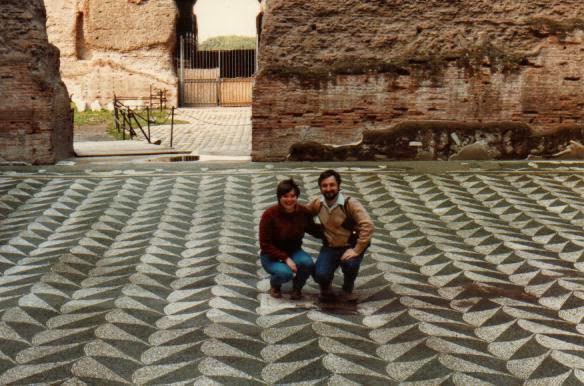"Swimming was one of the favourite activities of Roman boys, and it was widely practiced in the Tiber River, next to the Campus Martius. Most Roman baths were also equipped with plunge pools, in which swimming was enjoyed. There are some accounts of women who knew how to swim in ancient times." (this website)
Julius Caesar was famous for his swimming ability.
Swimming was part of boys' education, and the Romans built the first swimming pools separate from bathing pools.
"The first heated swimming pool was built by Gaius Maecenas of Rome in the 1st century BC.
The Baths of Caracalla and other baths built by the Romans were enormous, but the swimming tanks set aside for actual swimming were usually very small, although the natatio - the open air swimming pool rather than the bathing pools - measured 50 x 22 metres (source: Wikipedia). The walls rose to more than 20 metres and the northern facade was structured by three huge columns made from grey granite. Between these columns were niches on several levels for housing ornamental statues. It was roofless, with bronze mirrors mountes overhead to direct sunlight into the pool area. The entire bath area was on a raised platform 6 metres high, to allow for storage and furnaces under the building.
Below: The Baths of Caracalla (multimedia reconstruction and aerial plan)


 |
| Piero and me at the Baths of Caracalla in January 1984. In the summer of 1992 we went to see a performance of Aida there. |
According to Wikipedia, Caracalla was built between 212 and 216 AD under the reign of Emperor Caracalla. They also incorporated a library with two separate and equal sized rooms: one housing Greek langauge texts, and the other Latin language texts.
They were the inspiration for the design of Pennsylvania Station in New York City.
Ancient Pompei - the Stabian Baths
For detailed information about these baths, click here.
There was a pool measuring 13m x 8m and 1.5 m deep. On either side were shallow basins where athletes could wash prior to entering the pool.
Cicero complained that he needed a wider pool to avoid hurting his hands against the wall.
The Palaestra (a series of small rooms containing baths), with a swimming pool in the middle:
The plan of the baths above is from this website. "V" represents the pool, "S" the Palaestra.
Other features of the complex:
A: main entrance on Via Abbondanza
B: secondary entrance off Via Stabiana
C: ?
D and E: original entry to women's baths (no access to palaestra)
F: an entrance
G: an entrance
H: an entrance
I to N: Men's baths
I: small annexe of apodyterium
J: Vestibule to men's baths
K: Changing room (apodyterium)
L: Tepidarium (warm room)
M: Caldarium (hot room)
N: Frigidarium (cold room)
O: ?
P: Tepidarium women's baths
Q: Caldarium women's baths
R: ambulatory goving entrance to women's baths
T: dressing room for the pool complex
U and W: wash rooms for swimmers
X: Locker room for players of a game resembling ninepins
Y: Latrines
Z: Individual bathing rooms
The Palaestra (a series of small rooms containing baths), with a swimming pool in the middle:
 |
| Own photo taken on visit 30 May 2008 |
 |
| Photo taken 30 May 2008 |
The plan of the baths above is from this website. "V" represents the pool, "S" the Palaestra.
Other features of the complex:
A: main entrance on Via Abbondanza
B: secondary entrance off Via Stabiana
C: ?
D and E: original entry to women's baths (no access to palaestra)
F: an entrance
G: an entrance
H: an entrance
I to N: Men's baths
I: small annexe of apodyterium
J: Vestibule to men's baths
K: Changing room (apodyterium)
L: Tepidarium (warm room)
M: Caldarium (hot room)
N: Frigidarium (cold room)
O: ?
P: Tepidarium women's baths
Q: Caldarium women's baths
R: ambulatory goving entrance to women's baths
T: dressing room for the pool complex
U and W: wash rooms for swimmers
X: Locker room for players of a game resembling ninepins
Y: Latrines
Z: Individual bathing rooms



No comments:
Post a Comment